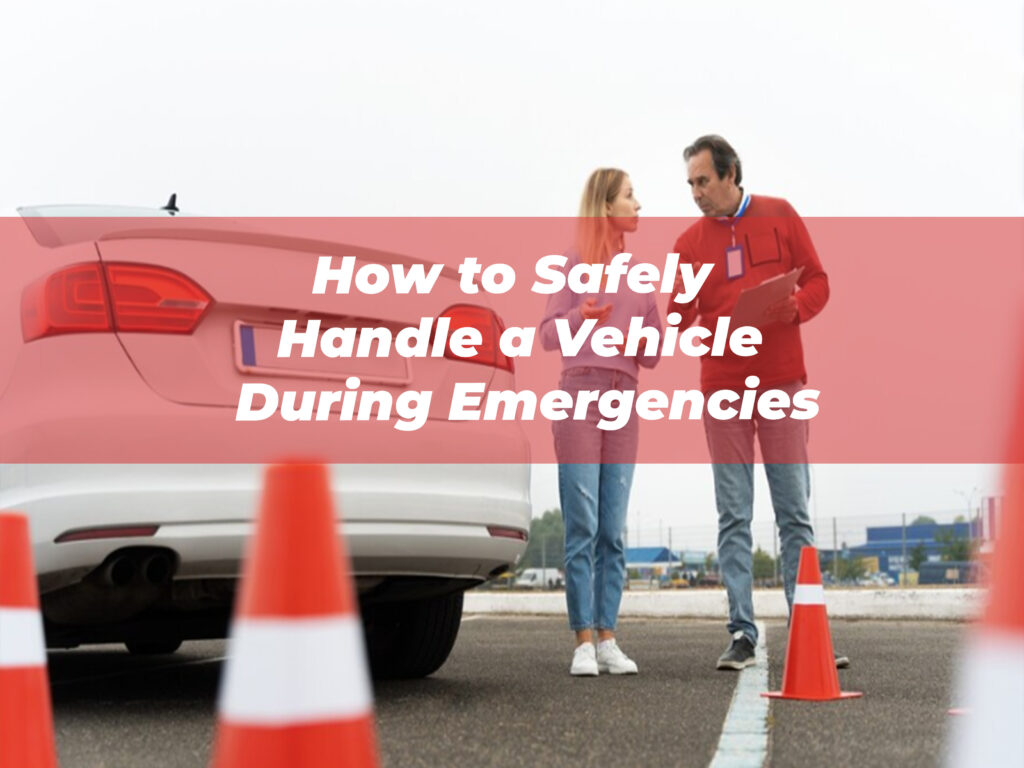Safely Handle a Vehicle can be one of the most convenient ways to travel, but emergencies on the road can happen when you least expect them. Knowing how to safely handle your vehicle in challenging situations can be the difference between a close call and a disaster. Whether you’re an experienced driver or a beginner, understanding how to respond to emergencies is a critical skill.
This blog post will explore common driving emergencies and provide clear, actionable advice for handling them safely. From tire blowouts to skidding and brake failure, let’s cover how to prepare and respond like a pro.
Understanding the Importance of Emergency Readiness
Emergencies on the road don’t usually come with a warning. A nail on the Safely Handle a Vehicle, a sudden slick of oil, or unexpected engine trouble can turn a regular drive into a serious situation. Your ability to stay calm and react appropriately plays a significant role in minimizing risks to yourself, your passengers, and other road users.
Being prepared for emergencies starts with awareness. By educating yourself about the proper responses to these scenarios, you’ll not only protect lives but also reduce vehicle damage and potential expenses.
How to Stay Calm During a Driving Emergency Safely Handle a Vehicle
Before we jump into specific situations, let’s talk about Safely Handle a Vehicle calm. Panicking during an emergency often leads to poor decisions. If you notice a sudden issue with your vehicle, follow these steps to regain control:
- Breathe deeply and focus on the task at hand.
- Avoid sudden movements that could worsen the situation.
- Remember that you have more control when you think and act decisively.
Preparation and composure can stop an emergency from Safely Handle a Vehicle. With that in mind, let’s get into some specific driving scenarios and how to safely handle your vehicle during each.
1. Managing a Tire Blowout
A tire blowout can happen without warning, especially if you’re driving at high speeds or your tires are under-inflated. The loud pop followed by your car pulling to one side can be frightening, but here’s how to react:
What to Do:
- Grip the steering wheel firmly. The car may pull sharply in one direction, so maintain control.
- Avoid slamming on the brakes. Braking suddenly can cause the car to spin or lose balance.
- Ease off the accelerator. Gradually reduce speed until you can safely pull over to the side of the road.
- Once stopped, turn on your hazard lights and assess the Safely Handle a Vehicle.
Pro Tip:
Regularly inspect your tires for wear and Safely Handle a Vehicle. Keeping them properly inflated and replacing worn-out ones reduces the chances of a blowout.
2. Handling Brake Failure
Brake failure is one of the most alarming situations a driver can face. Pressing the brake pedal only to feel nothing happen can lead to panic, but quick thinking can save you.
What to Do:
- Pump the brake pedal. If your car has a hydraulic brake system, this might restore some braking power.
- Downshift to a lower gear. Whether you drive a manual or automatic transmission, shifting to a lower gear can slow your Safely Handle a Vehicle.
- Use the emergency brake carefully. Pull the handbrake slowly to avoid locking the wheels and losing control.
- Steer toward a safe zone. Look for an empty shoulder, uphill incline, or soft ground to bring the car to a stop.
Pro Tip:
Regular maintenance of your braking system is crucial. Look out for warning signs like squeaking or grinding brakes, and address them promptly.
3. Skidding on Wet or Icy Roads
Losing traction on slippery roads can cause your car to Safely Handle a Vehicle. Whether it’s hydroplaning on wet pavement or sliding on ice, staying calm and knowing how to maneuver is vital.
What to Do:
- Steer into the skid. If the rear of your car starts to slide, gently steer in the direction you want to go. This helps you regain control.
- Avoid braking or accelerating suddenly. This can make the skid worse. Instead, ease off the accelerator and keep your movements smooth.
- Keep your eyes focused on where you want to go. Your hands will naturally follow your line of sight, making it easier to correct the skid.
Pro Tip:
Equip your car with all-season or winter tires if you live in areas prone to icy conditions. These provide better grip and reduce skidding risks.

4. Dealing with Engine Overheating
An overheating engine can lead to serious damage if not addressed immediately. Recognizing the early warning signs, such as your temperature gauge climbing or steam escaping from under the hood, is Safely Handle a Vehicle.
What to Do:
- Turn off the AC and turn on the heater. This might sound counterintuitive, but it pulls heat away from the Safely Handle a Vehicle.
- Pull over as soon as possible. Stop in a safe location to avoid further overheating.
- Open the hood cautiously. Wait until the engine cools down before opening the hood to check the coolant level.
- Never open the radiator cap when hot. The pressure can cause a dangerous spray of steam and hot coolant.
Pro Tip:
Regularly check coolant levels and inspect belts and hoses for wear. Preventative care can keep your engine running smoothly.
5. Responding to Sudden Steering Failure
A steering failure can leave you feeling helpless, but there are ways to bring your car safely to a halt.
What to Do:
- Grip the wheel tightly. Maintain as much control as Safely Handle a Vehicle.
- Reduce speed gradually. Take your foot off the accelerator and use your brakes gently.
- Engage your hazard lights. Signal to other drivers that you’re having car trouble.
- Steer with caution. If your steering becomes unresponsive, use the handbrake to slow down and stop.
Pro Tip:
Steering systems rarely fail without warning. Look out for difficulty turning the wheel or unusual noises when steering and have your car inspected promptly.6. Coping with Sudden Loss of Visibility
Heavy rain, fog, or unexpected debris can drastically reduce visibility. When this happens, staying calm and following basic safety steps can prevent accidents.
What to Do:
- Turn on your headlights or fog lights. Ensure other drivers can see you, especially during fog or rain.
- Slow down to a safe speed. Ensure you have enough time to react to Safely Handle a Vehicle.
- Pull over if necessary. If the conditions are too severe, find a safe spot to stop until visibility improves.
Pro Tip:
Keep your windshield wipers and defogging systems in good condition. Clean your windshield regularly to avoid glare.
7. Navigating Through Flash Floods or Standing Water
Driving through water can damage your car or even cause it to be swept away. Never underestimate the power of moving water, no matter how shallow it seems.
What to Do:
- Avoid driving through standing water if possible. Turn around and find another route.
- Test the depth before proceeding. Use landmarks like curbs or road markings to gauge how deep the water is. If it’s deeper than your tire’s height, don’t attempt to cross.
- Drive slowly and steadily. Maintain a low and Safely Handle a Vehicle speed to minimize water entering the engine.
- Dry your brakes afterward. After exiting water, lightly press on your brake pedal to ensure they function properly.
Pro Tip:
Always check weather reports and road conditions before traveling in flood-prone areas.
8. What to Do During a Vehicle Fire
Although rare, vehicle fires are dangerous and require immediate action. Quick thinking can save lives in this life-threatening scenario.
What to Do:
- Pull over immediately. Stop in a safe spot away from traffic and other vehicles.
- Turn off the ignition. This cuts off the fuel supply to the engine.
- Evacuate the vehicle. Get all passengers and yourself at least 100 feet away from the car.
- Call emergency services. Inform them of the situation and avoid attempting to extinguish the fire unless it’s small and manageable.
Pro Tip:
Carry a fire extinguisher rated for vehicles as part of your emergency kit.
Essential Emergency Tools Every Driver Should Have
Preparation is key to handling emergencies calmly and Safely Handle a Vehicle. Equip your car with these must-have tools and supplies:
- A fully-stocked first aid kit
- Jumper cables or a portable jump starter
- A durable flashlight with extra batteries
- A tire repair kit and spare tire
- Fire extinguisher
- Non-perishable snacks and water
- Reflective warning triangles or flares
- Multi-tool or Swiss army knife
- An updated roadside assistance contact
Being proactive about your car’s maintenance and having these tools on hand can give you peace of mind when facing potential emergencies.
Final Thoughts
Vehicle emergencies can be Safely Handle a Vehicle, but the right knowledge and preparation can make all the difference. Whether it’s a tire blowout, skidding on ice, or engine trouble, staying calm and knowing how to respond can prevent escalated risks. Start by maintaining your vehicle with regular checkups, investing in essential safety tools, and educating yourself on how to react in unexpected situations.
By taking these steps, you’re not only protecting yourself but also ensuring safety for everyone on the road. Remember, safe driving is a skill that requires practice and preparation. Stay informed, stay prepared, and always prioritize safety.
Now it’s your turn! Share this post with your Safely Handle a Vehicle to make sure they know what to do in a driving emergency. And don’t forget to keep your car emergency kit updated and your vehicle well-maintained.










